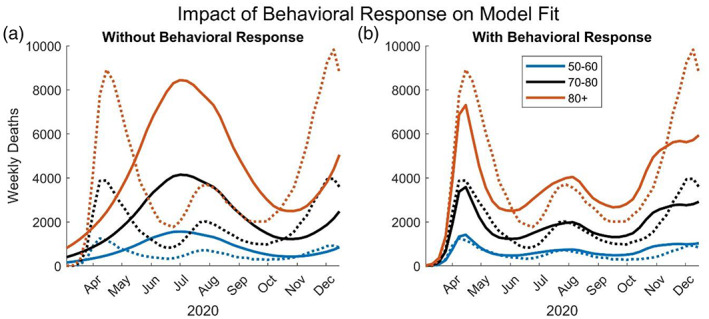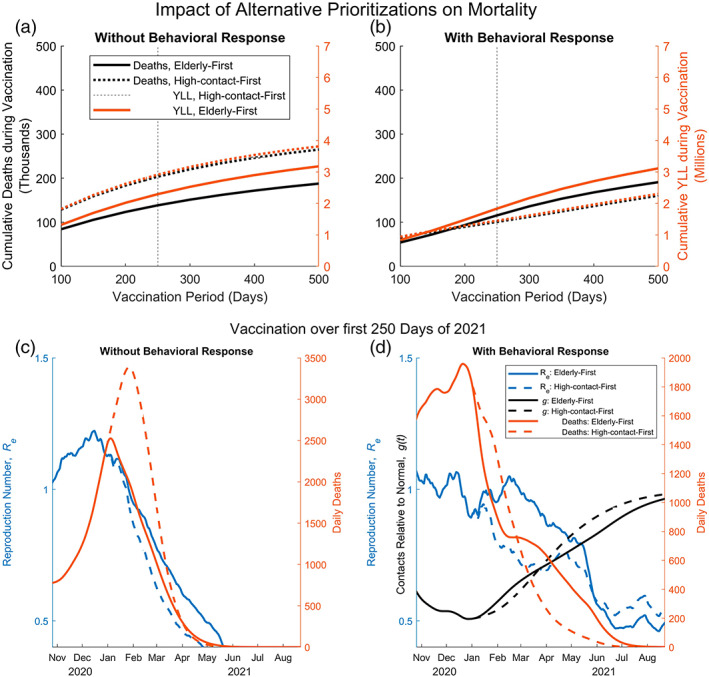下载PDF
{"title":"对风险的行为反应促使首先为高接触者接种疫苗。","authors":"Hazhir Rahmandad","doi":"10.1002/sdr.1714","DOIUrl":null,"url":null,"abstract":"<p><p>How should communities prioritize COVID-19 vaccinations? Prior studies found that prioritizing the elderly and most vulnerable minimizes deaths. However, prior research has ignored how behavioral responses to risk of disease endogenously change transmission rates. We show that incorporating risk-driven behavioral responses enhances fit to data and may change prioritization to vaccinating high-contact individuals. Behavioral responses matter because deaths grow exponentially until communities are compelled to reduce contacts, with deaths stabilizing at levels that oblige higher-contact groups to sufficiently cut their interactions and slow transmissions. More lives may be saved by vaccinating and taking those high-contact groups out of transmission chains earlier because the remaining groups will take more precautions while waiting for their turn for vaccination. These findings are especially important considering the need for further vaccination in many countries, the emergence of new variants, and the expected challenge of distributing new vaccines in the coming months and years. © 2022 The Author. <i>System Dynamics Review</i> published by John Wiley & Sons Ltd on behalf of System Dynamics Society.</p>","PeriodicalId":51500,"journal":{"name":"System Dynamics Review","volume":"38 3","pages":"246-263"},"PeriodicalIF":1.7000,"publicationDate":"2022-07-01","publicationTypes":"Journal Article","fieldsOfStudy":null,"isOpenAccess":false,"openAccessPdf":"https://ftp.ncbi.nlm.nih.gov/pub/pmc/oa_pdf/34/2b/SDR-38-246.PMC9537883.pdf","citationCount":"10","resultStr":"{\"title\":\"Behavioral responses to risk promote vaccinating high-contact individuals first.\",\"authors\":\"Hazhir Rahmandad\",\"doi\":\"10.1002/sdr.1714\",\"DOIUrl\":null,\"url\":null,\"abstract\":\"<p><p>How should communities prioritize COVID-19 vaccinations? Prior studies found that prioritizing the elderly and most vulnerable minimizes deaths. However, prior research has ignored how behavioral responses to risk of disease endogenously change transmission rates. We show that incorporating risk-driven behavioral responses enhances fit to data and may change prioritization to vaccinating high-contact individuals. Behavioral responses matter because deaths grow exponentially until communities are compelled to reduce contacts, with deaths stabilizing at levels that oblige higher-contact groups to sufficiently cut their interactions and slow transmissions. More lives may be saved by vaccinating and taking those high-contact groups out of transmission chains earlier because the remaining groups will take more precautions while waiting for their turn for vaccination. These findings are especially important considering the need for further vaccination in many countries, the emergence of new variants, and the expected challenge of distributing new vaccines in the coming months and years. © 2022 The Author. <i>System Dynamics Review</i> published by John Wiley & Sons Ltd on behalf of System Dynamics Society.</p>\",\"PeriodicalId\":51500,\"journal\":{\"name\":\"System Dynamics Review\",\"volume\":\"38 3\",\"pages\":\"246-263\"},\"PeriodicalIF\":1.7000,\"publicationDate\":\"2022-07-01\",\"publicationTypes\":\"Journal Article\",\"fieldsOfStudy\":null,\"isOpenAccess\":false,\"openAccessPdf\":\"https://ftp.ncbi.nlm.nih.gov/pub/pmc/oa_pdf/34/2b/SDR-38-246.PMC9537883.pdf\",\"citationCount\":\"10\",\"resultStr\":null,\"platform\":\"Semanticscholar\",\"paperid\":null,\"PeriodicalName\":\"System Dynamics Review\",\"FirstCategoryId\":\"91\",\"ListUrlMain\":\"https://doi.org/10.1002/sdr.1714\",\"RegionNum\":3,\"RegionCategory\":\"管理学\",\"ArticlePicture\":[],\"TitleCN\":null,\"AbstractTextCN\":null,\"PMCID\":null,\"EPubDate\":\"2022/8/23 0:00:00\",\"PubModel\":\"Epub\",\"JCR\":\"Q3\",\"JCRName\":\"MANAGEMENT\",\"Score\":null,\"Total\":0}","platform":"Semanticscholar","paperid":null,"PeriodicalName":"System Dynamics Review","FirstCategoryId":"91","ListUrlMain":"https://doi.org/10.1002/sdr.1714","RegionNum":3,"RegionCategory":"管理学","ArticlePicture":[],"TitleCN":null,"AbstractTextCN":null,"PMCID":null,"EPubDate":"2022/8/23 0:00:00","PubModel":"Epub","JCR":"Q3","JCRName":"MANAGEMENT","Score":null,"Total":0}
引用次数: 10
引用
批量引用




 求助内容:
求助内容: 应助结果提醒方式:
应助结果提醒方式:


